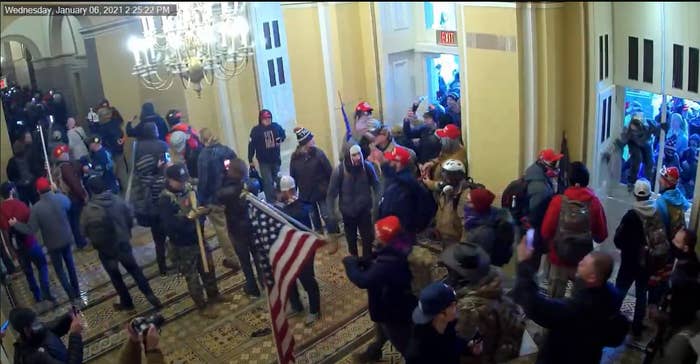
WASHINGTON — Federal prosecutors on Tuesday released a new collection of Capitol surveillance videos from Jan. 6 after a judge ordered them to do so, rejecting the government’s argument that making the clips public could threaten the security of the complex.
The disclosure marks a setback for the US Capitol Police and the US attorney’s office in their efforts to control how much footage from the Capitol’s closed-circuit video (CCV) system gets out. In the latest case, prosecutors argued that revealing the location and vantage points of more cameras could help “bad actors” trying to plan some future assault on the building. A judge concluded that argument was too speculative, however, and that the public had a strong interest in seeing videos that formed the basis for a recent plea deal.
US District Chief Judge Beryl Howell ordered the videos released in response to a request from a media coalition (including BuzzFeed News) that is petitioning judges on a rolling basis for videos that prosecutors have relied on in Jan. 6 cases. Howell’s decision isn’t binding on other judges in the US District Court for the District of Columbia presiding over Capitol riot prosecutions, but it gives the media coalition a favorable ruling to point to in future fights.
The clips cover a period of about 15 minutes on Jan. 6 — between 2:25 p.m. and 2:40 p.m. — in different locations inside the Capitol. They show rioters streaming through open doors and broken windows at an entrance on the Senate side; crowds of people walking into the Crypt, standing in a large crowd, and eventually dispersing; and, finally, rioters exiting as US Capitol Police officers in riot gear gather at the Senate entrance point to stand guard as a mob that’s outside looks in through the broken windows. There is no audio. The cameras are stationed up high and at a distance, providing a wide, stable perspective on the scene.
There has been a wealth of video evidence in connection with the insurrection, including videos recorded by rioters that were posted online and footage recorded by police body cameras. According to the US Capitol Police, the CCV system captured more than 14,000 hours of footage between noon and 8 p.m. on Jan. 6, creating the most complete video archive of events inside the building that day. USCP has strictly controlled who can access the footage and how much of it can be released to the public; some of it was shared during former president Donald Trump’s impeachment trial in February.
The government cited the latest videos in the case of Eric Torrens, a Tennessee man who took a deal with prosecutors and pleaded guilty on Aug. 19 to one misdemeanor count of illegally parading, demonstrating, or picketing in the Capitol. He admitted entering the building through a broken door and walking around. The government noted in court papers that Capitol surveillance cameras recorded his entry into the building as well as his movements inside. Prosecutors cited four other videos they obtained related to Torrens, including one that showed him exclaiming, “We goin' in!” Those were also released on Tuesday.
Video of Eric Torrens (in the fleece-lined hat) and others entering the Capitol
Before Torrens’ plea hearing, Howell asked to see videos that the government relied on in describing Torrens’ conduct. She also asked the parties to weigh in on whether those videos should be released to the public. At the plea hearing, Howell noted that there was a presumption in favor of access to judicial proceedings and that the public had an interest in materials that were submitted in court, that judges relied on in making decisions, and that shed light on how prosecutors exercised discretion in criminal cases.
The government opposed making the videos public. In response to a petition filed by the media coalition, prosecutors wrote that the videos featured nonpublic information about entrances and exits around the Capitol, and that releasing them would “compromise the security of the United States Capitol and those who work there.”
“This footage, when combined with other footage from nearby cameras, could be used to track individual rioters moving through the building thereby creating a visual pathway which other bad actors could use in planning their breach point and pathway for future attacks,” prosecutors wrote.
Lawyers for the media coalition argued the government’s national security concerns were too speculative and undermined by the fact that prosecutors in a few other cases had voluntarily released some surveillance footage.
Howell sided with the media coalition, writing in a Sept. 15 opinion that the national security concerns weren’t specific enough. The government might have a stronger case for keeping videos secret that revealed “sensitive” parts of the building, but that wasn’t at issue, she wrote — anyone taking a public tour could see the areas shown in these videos.
“Hundreds of cases have arisen from the events of January 6, with new cases being brought and pending cases being resolved by plea agreement every week,” Howell wrote. “The public has an interest in understanding the conduct underlying the charges in these cases, as well as the government’s prosecutorial decision-making both in bringing criminal charges and resolving these charges by entering into plea agreements with defendants.”
The five Capitol surveillance videos released by the government are shown below:

